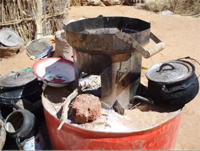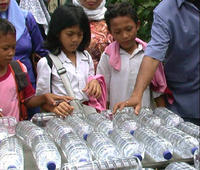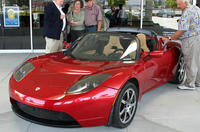-
Defying governor, Mass. officials seek to join Secure Communities

Local law enforcement officials and state lawmakers are increasingly working to circumvent Massachusetts governor Deval Patrick’s decision to opt out of the controversial Secure Communities immigration program; last Wednesday U.S Senator Scott Brown (R-Massachusetts) called on DHS secretary Janet Napolitano to allow the state to join Secure Communities without Governor Patrick’s approval; Under Secure Communities, a detained individual’s fingerprints are automatically scanned and checked against DHS and FBI databases to determine their immigration status
-
-
Safe, efficient cookstoves for earthquake survivors

316,000 people were killed and more than one million made homeless by the 12 January 2010 magnitude 7.0 quake that left the capital city of Port-au-Prince in ruins; many of the displaced Haitians still live in tent cities, where even simple tasks such as cooking are a challenge; scientists hope to find the safest and most energy-efficient way for earthquake survivors to cook
-
-
Self-repairing composites repair cracks in coating of buildings, bridges
Researchers have developed vascularized structural composites, creating materials that are lightweight and strong with potential for self-healing, self-cooling, metamaterials, and more; these artificial microvascular systems can self-repair of materials damage, such as cracks in a coating applied to a building or bridge
-
-
Solar UV disinfects drinking water

More than 800 million people around the world lack access to clean water; the water available for people to drink in many developing countries has not been treated to remove contaminants, including pathogenic microorganisms; half of the world’s hospital beds are occupied by people who are sickened by the water they drink; Purdue University researchers have invented a water-disinfection system that uses the sun’s ultraviolet radiation to inactivate waterborne pathogens
-
-
Protecting structures against firebrand attack
NIST engineers have built a device that bellows showers of glowing embers, or firebrands, to test how structures can withstand this destructive aspects of wild fires; in Japan, where the device is now used in a test facility, firebrands are a growing peril that accounts for half of the nation’s ten most costly fires
-
-
Belief that others can change could bring peace
Psychologists find that members of groups engaged in conflict are more willing to compromise if they believe people are capable of changing; when researchers presented Israelis and Palestinians with evidence that groups of people are capable of change, the information increased the subjects’ willingness to compromise on key political issues
-
-
E-textiles now come with memory-storing fiber
E-textiles could help soldiers, first responders — but also the sick and infirm; the integration of electronics into textiles is a growing field of research that may soon enable smart fabrics and wearable electronics
-
-
Georgia shows app that prepares state residents, guides them to safety
New Ready Georgia mobile app uses geo-location to deliver alerts, create emergency plans, and show shelter locations; from up-to-the-minute weather and hazard alerts based on a user’
‘s location, to customizable emergency preparedness checklists, the app combines a set of features not previously available in one mobile application -
-
Shells tracked by radar
With the high costs of live fire training, the Pentagon wanted a shell-scoring system, and commissioned Cambridge Consultants to develop one; after fourteen months of development, the company unveiled its holographic radar scoring system, the Land and Surface Target Scorer (LSTS)
-
-
Anti-magnet: to protect ships' hulls from mines
Researchers have created a new type of magnetic cloak which shields objects from magnetic fields — at the same time that it prevents any internal magnetic fields from leaking out; this “antimagnet” could be used to protect a ship’s hulls from mines that detonate when a magnetic field is detected
-
-
The Certified Protection Officer (CPO) 8th Edition launched
The updated version of a training course for Certified Protection Officers is now available online; the course and exam provide candidates with the IFPO certification; the course offers training in security technology, laws, trends, and techniques
-
-
Global water market could hit $800 billion by 2035
Analysts are predicting that the global market for water could grow dramatically over the next two decades, with some projecting a $1 trillion market in 2020; “Water is the fastest growing market at the moment, with a size of $500 billion globally,” said Harri Kerminen, the president and CEO of Finnish chemical firm Kemira
-
-
Speeding skyscraper construction -- and making them stronger
Researchers are working on a new technique that could speed construction of skyscrapers while also providing enough stiffness and strength to withstand earthquakes and forces from high winds
-
-
Proton-based transistor could let machines communicate with humans
Devices humans use, from light bulbs to iPods, send information using electrons; human bodies and all other living things, on the other hand, send signals and perform work using ions or protons; researchers build a novel transistor that uses protons, creating a key piece for devices that can communicate directly with living things
-
-
Future electric vehicle to run unlimited distances

Electrically powered vehicles (EV) are promising environmentally friendly alternatives for combustion engine-based automobiles; batteries used in present-day EV, however, limit the continuous running distance from one charge; researchers propose a potentially revolutionary solution for powering EVs capable of running unlimited distances
-
More headlines
The long view
New Technology is Keeping the Skies Safe
DHS S&T Baggage, Cargo, and People Screening (BCP) Program develops state-of-the-art screening solutions to help secure airspace, communities, and borders
Factories First: Winning the Drone War Before It Starts
Wars are won by factories before they are won on the battlefield,Martin C. Feldmann writes, noting that the United States lacks the manufacturing depth for the coming drone age. Rectifying this situation “will take far more than procurement tweaks,” Feldmann writes. “It demands a national-level, wartime-scale industrial mobilization.”
How Artificial General Intelligence Could Affect the Rise and Fall of Nations
Visions for potential AGI futures: A new report from RAND aims to stimulate thinking among policymakers about possible impacts of the development of artificial general intelligence (AGI) on geopolitics and the world order.
Smaller Nuclear Reactors Spark Renewed Interest in a Once-Shunned Energy Source
In the past two years, half the states have taken action to promote nuclear power, from creating nuclear task forces to integrating nuclear into long-term energy plans.
Keeping the Lights on with Nuclear Waste: Radiochemistry Transforms Nuclear Waste into Strategic Materials
How UNLV radiochemistry is pioneering the future of energy in the Southwest by salvaging strategic materials from nuclear dumps –and making it safe.
Model Predicts Long-Term Effects of Nuclear Waste on Underground Disposal Systems
The simulations matched results from an underground lab experiment in Switzerland, suggesting modeling could be used to validate the safety of nuclear disposal sites.
